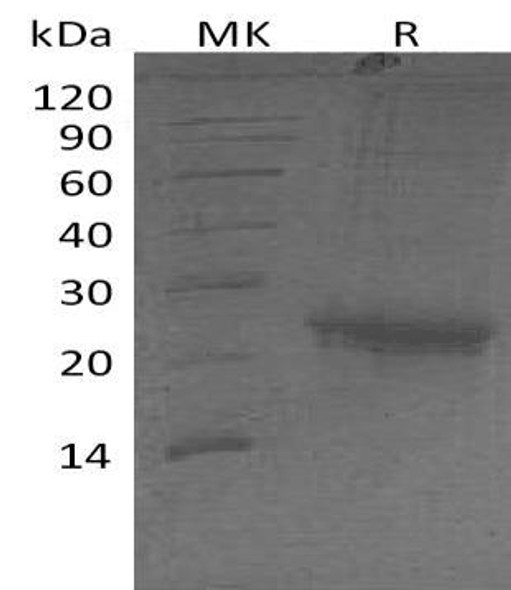Description
| Product Name: | Human PVRL1/NECTIN1/CD111 Recombinant Protein (His tag) |
| Product Code: | RPES6058 |
| Size: | 20µg |
| Species: | Human |
| Expression Host: | HEK293 Cells |
| Synonyms: | Poliovirus Receptor-Related Protein 1, Herpes Virus Entry Mediator C, Herpesvirus Entry Mediator C, HveC, Herpesvirus Ig-Like Receptor, HIgR, Nectin-1, CD111, PVRL1, HVEC, PRR1, ED4, HIgR, HV1S, HVEC, nectin-1, OFC7, PRR, PVRR, PVRR1, SK-12 |
| Mol Mass: | 36.63 kDa |
| AP Mol Mass: | 45 kDa |
| Tag: | C-His |
| Purity: | > 95 % as determined by reducing SDS-PAGE. |
| Endotoxin Level: | Please contact us for more information. |
| Bio Activity: | Testing in progress |
| Sequence: | Met1-Thr334 |
| Accession: | Q15223 |
| Storage: | Generally, lyophilized proteins are stable for up to 12 months when stored at -20 to -80°C. Reconstituted protein solution can be stored at 4-8°C for 2-7 days. Aliquots of reconstituted samples are stable at < -20°C for 3 months. |
| Shipping: | This product is provided as lyophilized powder which is shipped with ice packs. |
| Formulation: | Lyophilized from sterile PBS, pH 7.4. Normally 5 % - 8 % trehalose, mannitol and 0.01% Tween80 are added as protectants before lyophilization. Please refer to the specific buffer information in the printed manual. |
| Reconstitution: | Please refer to the printed manual for detailed information. |
| Background: | Nectin-1 is a type I transmembrane glycoprotein belonging to the Ig superfamily. Nectin-1 promotes cell-cell contacts by forming homophilic or heterophilic trans-dimers. Heterophilic interactions have been detected between Nectin-1 and Nectin-3 and between Nectin-1 and Nectin-4. Nectin ECDs contain three Ig like domains: an N terminal V type that mediates ligand binding, and two C2 type. Nectin-1 binds viral Glycoprotein D to mediate Herpesvirus (but not Poxvirus) entry into vaginal mucosa, sensory neurons and fibroblasts. In forming adherens junctions and synapses, Nectin-1 and Nectin-3 initiate cell-cell interactions, recruiting αvβ3 integrin extracellularly and cadherins intracellularly through afadin and other junctional proteins. These interactions organize the cytoskeleton, strengthen attachment to basement membrane and promote further cell-cell connections. Nectin-1 and Nectin-3 have been found to localize assymetrically along the chemical synapse, with Nectin-1 primarily on the axonal side and Nectin-3 on the dendritic side. Deficiency of Nectin-1 can result in cleft lip/palate ectodermal dysplasia. Nectin-1 downregulation in epithelial cancers is mediated in part by ectodomain shedding, but it may contribute to invasiveness. |






